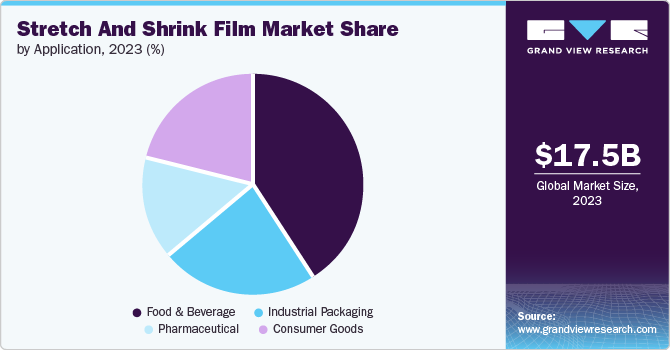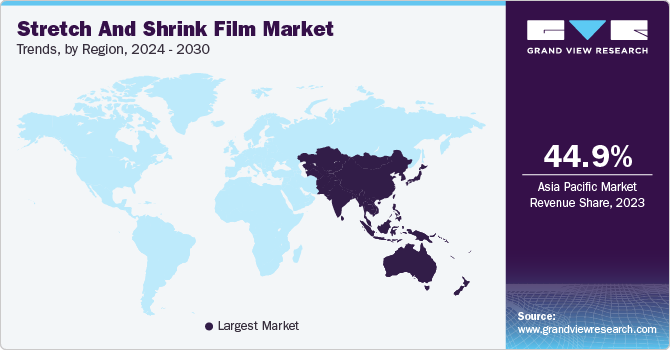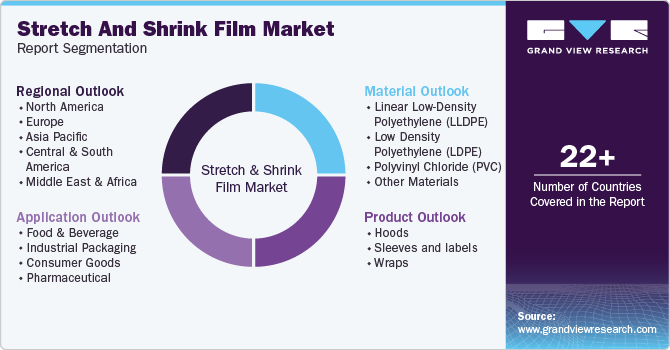
Stretch And Shrink Film Market Size, Share & Trends Analysis Report By Material (LLDPE, LDPE, PVC, Others), By Product (Hoods, Sleeves & Labels, Wraps), By Application, By Region, And Segment Forecasts, 2024 - 2030
- Report ID: GVR-1-68038-124-5
- Number of Report Pages: 180
- Format: PDF, Horizon Databook
- Historical Range: 2018 - 2022
- Forecast Period: 2024 - 2030
- Industry: Bulk Chemicals
Stretch And Shrink Film Market Trends
The global stretch and shrink film market size was estimated at USD 17.46 billion in 2023 and is expected to expand at a CAGR of 5.3% from 2024 to 2030. The increasing demand for packaged food products such as frozen meat, seafood, and poultry is expected to drive the demand for stretch and shrink films, which are used as secondary packaging materials.

This, in turn, is anticipated to positively impact the growth of the market across the world in the coming years. Stretch and shrink films are primarily used for the packaging of industrial goods, food & beverage products, consumer goods, and pharmaceutical products. The requirement for a strong, flexible packaging material with the ability to withstand high-impact damages is expected to drive the demand for the films over the forecast period. These films are predominantly used for food packaging owing to easy sterilization coupled with high packaging flexibility leading to better unitization. In addition, shrink and stretch films are largely used in packaging owing to superior characteristics, including ease of printing on the film surface, high impact, and damage resistance.
These films find application in the beverage and consumer goods packaging industry for the packaging of a large number of carbonated soft drinks and alcoholic beverages due to easier printing on the surface of the films. Alcohol manufacturing makes use of printed packaging films to differentiate their products and improve the aesthetic appeal of beverages. The films are primarily used for unitizing PET bottles and beverage cans in the beverage packaging industry with a printed stretch or shrink film.
Market Concentration & Characteristics
Prominent stretch and shrink film companies operating in the market include Berry Global Inc., Amcor plc, Bonset America Corporation, Allen Plastic Industries Co., Ltd, Bollore Inc., American Eagle Packaging, Coveris Holdings, and Barbier Group.

Companies operating in the stretch and shrink film industry are undertaking strategic initiatives such as new product launches and mergers & acquisitions to strengthen their market presence. For instance, on March 21, 2024, shrink film manufacturer Shantou Mingca Packaging and ExxonMobil Asia Pacific Research & Development introduced a double bubble polyethylene (PE)-based shrink film (PEF) solution. This next-generation polyolefin shrink film (POF) has been developed using ultra-low density Exceed XP performance PE. The new shrink film solution is versatile and suitable for a wide range of products, including personal care products, electronics, medicines, household items, and others. Its PE-based structure is designed to facilitate easier mechanical recycling than traditional POF solutions.
Material Insights
Based on material, the low-density polyethylene (LDPE) subsegment accounted for the largest revenue share, 30.5% of the market in 2023. The availability of LDPE stretch films in a variety of gauges and sizes for protecting and showcasing on-shelf packed products and maintaining the integrity of packaging solutions contributes to the growth of this segment of the market.
The LLDPE films segment is expected to witness growth owing to increased collaborations undertaken by key companies to develop LLDPE films. For instance, in June 2023, LyondellBasell Industries Holdings B.V., in collaboration with AFA Nord GmbH, announced a joint venture, LMF Nord GmbH, that is expected to offer recycled LLDPE stretch and shrink films by early 2025. Such developments and projects are expected to propel the demand for LLDPE stretch and shrink films over the forecast period.
Product Insights
Among products, the sleeve labels segment accounted for a revenue share of 38.2% in 2023. The large-scale global production of non-alcoholic beverages is expected to drive the demand for sleeve labels worldwide over the forecast period.
The use of stretch and shrink hoods in industrial applications is primarily for palletizing goods which is a major growth driver triggering the demand for stretch and shrink hoods. The ease of palletization achieved using stretch and shrink hoods is expected to emerge as one of the primary factors facilitating the substitution of other palletizing solutions with stretch and shrink hoods.
Application Insights
Food & beverages emerged as the most significant application segment of the market in 2023 by accounting for a share of 40.9% of the market. Increasing demand for packaged food products owing to the changing lifestyle and rising disposable income of consumers is expected to drive the growth of the food & beverages segment from 2024 to 2030.
Increasing government focus on public health and rising investment in the pharmaceutical sector to compete with emerging markets, including India, the U.S., and China, is expected to have a positive impact on the market growth over the forecast period. For instance, In June 2023, RK PHARMA, a U.S.-based pharmaceutical company with subsidiaries in India, received an investment of USD 200 million from PAG, an investment firm for pharmaceutical development in India.

Shrink films are used for packaging various consumer goods such as textile yarns, FMCG products, electrical and electronics products, specialty goods and shopping goods. Durability, reliability, and cost-effectiveness offered by shrink films as compared to conventional paper-based rigid packaging are expected to have a positive impact on the industry growth over the forecast period. In addition, stretch films are widely used for the packaging of consumer goods such as bottled beverages or cosmetic bottles and jars to combine multiple items into a single unit.
Regional Insights
The market for stretch and shrink films in North America is expected to grow significantly owing to high demand from the food and beverage industry. The presence of key food processing industries in the region, including PepsiCo Inc., Tyson Foods Inc., Nestle, Coca-Cola Co., JBS USA, and Mars Inc., is expected to open new avenues for product growth over the projected period.

U.S. Stretch and Shrink Film Market Trends
The stretch and shrink film market in the U.S. is expected to witness robust growth, as the U.S. is one of the major manufacturers of processed food, which finds high use of stretch films in both primary and secondary packaging. As a result, the demand for LDPE-based films for packaging food materials is expected to rise over the forecast period, leading to market growth. The demand for LLDPE-based stretch films is expected to grow on account of high transparency coupled with superior performance as a food contact material.
Asia Pacific Stretch And Shrink Film Market Trends
Asia Pacific stretch and shrink film market dominated globally and accounted for the largest revenue share of over 44.9% in 2023. The demand for stretch films is expected to be the highest in Asia Pacific on account of the presence of a strong food & beverage processing industry in the region. The increasing population in economies such as India and China, coupled with the growing disposable income of the consumers, is expected to increase the spending on food, resulting in an increased production of food. The region is home to a number of countries with high economic growth, which results in a high demand for packaging products. In addition, the growing efforts of the national governments in the region toward economic development are expected to benefit manufacturing industries, which is further expected to drive market growth.
The stretch and shrink film market in China is the major consumer for stretch films owing to the rapid growth of end-use industries such as consumer goods, electrical & electronics, textiles, chemicals, pharmaceuticals, toys, and food & beverages. Rising pharmaceutical industry in China in line with the demographic changes and strong economic growth is expected to open new avenues for the product.
Europe Stretch And Shrink Film Market Trends
The stretch and shrink film market in Europeis experiencing significant growth as the manufacturers in the region develop advanced products that conform to the mandated standards, thereby driving up the product prices in the region. Companies such as DowDupont and Sealed Air operate in the region through well-established distribution networks. High demand for the product in the food & beverage and packaged consumer goods industries is expected to benefit the market growth.
The Germany stretch and shrink film market is witnessingdemand for stretch films where the economy is expected to be driven by the presence of a strong food & beverage processing industry. Germany’s food sector accounts for 6.2% of the country’s economy. The country has over 6,000 companies operating in the food industry, which generates a high demand for packaging materials required for processed and unprocessed food. In addition, the demand for flexible packaging films is expected to be driven by their properties, such as ease of packaging and superior barrier properties.
Central & South America Stretch And Shrink Film Market Trends
The stretch and shrink film market in Central & South Americais anticipated to grow over the forecast period. The growing personal care industry in economies such as Brazil and Chile, on account of increasing expenditure on beauty and cosmetic products, is expected to force FMCG companies to increase their production capacities. As a result, the demand for packaging in personal care products and consumer goods is expected to rise, which, in turn, is likely to affect the stretch film market on a positive note.
Middle East & Africa Stretch And Shrink Film Market Trends
The Middle East & Africa stretch and shrink film marketdynamicsare influenced by the rise in international trade, and the growing emphasis on proper handling and transportation of personal care & cosmetics have contributed to the surge in demand for packaging. The food products manufacturing market in South Africa is dominated by local players. In the bakery products manufacturing segment, companies such as Tiger Brands, Pioneer Foods, FoodCorp, and Premier Foods account for approximately 80% of the overall bakery products market revenue in the economy. As a result, the companies account for a high demand for packaging materials such as stretch films. The films used in secondary packaging of beverages are majorly consumed by players such as The Coca-Cola Company, Pioneer Foods (which manufactures Pepsi under license), and Bromor Foods.
Key Stretch And Shrink Film Company Insights
The market for stretch and shrink film is moderately fragmented, with several key players operating globally. Major companies in this space include Sigma Plastics Group, Berry Global Inc., Paragon Films, Millennium Packaging, Inc., and Sealed Air. These companies continuously invest in research and development to introduce innovative and more sustainable ESD packaging solutions.
-
Sigma Plastics Group specializes in manufacturing extruded polyethylene bags and films. Its products include stretch films, custom films, and institutional products.
-
Bonset America Corporation offers flexible packaging products, including shrinkable films, packaging materials, electric devices, and agricultural films.
Key Stretch And Shrink Film Companies:
The following are the leading companies in the stretch and shrink film market. These companies collectively hold the largest market share and dictate industry trends.
- Sigma Plastics Group
- Berry Global Inc.
- Paragon Films
- Millennium Packaging, Inc
- Sealed Air
- HIPAC Spa
- Bollore Inc
- Amcor plc
- Italdibipack SpA
- LUBAN PACK
- A-Z Packaging
- FilmSource Packaging
- Atlantic Packaging
- Dow
- Shaktiman Packaging Pvt. Ltd.
- REELEX Packaging Solutions, Inc.
- Klöckner Pentaplast
- Balcan Innovations Inc
- Exxon Mobil Corporation
- Singhal Industries Pvt. Ltd.
Recent Developments
-
On February 16, 2024, Innovia Films launched floatable polyolefin shrink films. RayoFloat white APO is a low-density white polyolefin that maintains floatability when printed. Its opacity enhances light blocking, suitable for shrink sleeves for light-sensitive industries such as dairy, food supplements, nutritional products and cosmetics.
-
On February 13, 2024, IPG introduced polyolefin shrink film with 35% recycled content. ExlfilmPlus PCR features at least 10% certified PCR content and 25% certified PIR content. This design aligns with the increasing demand for eco-friendly packaging solutions that do not compromise on quality or performance. The film utilizes mechanically recycled post-consumer content sourced from consumer plastic waste and recycled into new resin.
-
In May 2023, Innovia Films introduced APO45, a floatable and sustainable shrink sleeve material developed to boost PET recycling rates and support a circular economy for packaging. The product is suitable for use in all shrink sleeve applications in the household, laundry, personal care, food, dairy, and beverage markets, states the company.
Stretch And Shrink Film Market Report Scope
|
Report Attribute |
Details |
|
Market size value in 2024 |
USD 18.46 billion |
|
Revenue forecast in 2030 |
USD 25.16 billion |
|
Growth rate |
CAGR of 5.3% from 2024 to 2030 |
|
Historical data |
2018 - 2022 |
|
Forecast period |
2024 - 2030 |
|
Quantitative units |
Revenue in USD Billion and CAGR from 2024 to 2030 |
|
Report coverage |
Revenue forecast, competitive landscape, growth factors, and trends |
|
Segments covered |
Material, product, application, region |
|
Regional scope |
North America; Europe; Asia Pacific; Central & South America; Middle East & Africa |
|
Country Scope |
U.S.; Canada; Mexico; Germany; UK; France; Italy; Spain; China; India; Japan; South Korea; Australia; Brazil; South Africa |
|
Key companies profiled |
Sigma Plastics Group; Berry Global Inc.; Paragon Films; Millennium Packaging, Inc; Sealed Air; HIPAC Spa; Bollore Inc; Amcor plc; Italdibipack SpA; LUBAN PACK; A-Z Packaging; FilmSource Packaging; Atlantic Packaging; Dow; Shaktiman Packaging Pvt. Ltd.; REELEX Packaging Solutions, Inc.; Klöckner Pentaplast; Balcan Innovations Inc; Exxon Mobil Corporation; Singhal Industries Pvt. Ltd. |
|
Customization scope |
Free report customization (equivalent up to 8 analyst’s working days) with purchase. Addition or alteration to country, regional & segment scope |
|
Pricing and purchase options |
Avail customized purchase options to meet your exact research needs. Explore purchase options |
Global Stretch And Shrink Film Market Report Segmentation
This report forecasts revenue growth at global, regional, and country levels and provides an analysis of the latest industry trends in each of the sub-segments from 2018 to 2030. For this study, Grand View Research has segmented the global stretch and shrink film market report based on material, product, application, and region:

-
Material Outlook (Revenue, USD Billion, 2018 - 2030)
-
Linear Low-Density Polyethylene (LLDPE)
-
Low Density Polyethylene (LDPE)
-
Polyvinyl Chloride (PVC)
-
Other Materials
-
-
Product Outlook (Revenue, USD Billion, 2018 - 2030)
-
Hoods
-
Sleeves and labels
-
Wraps
-
-
Application Outlook (Revenue, USD Billion, 2018 - 2030)
-
Food & beverage
-
Industrial packaging
-
Consumer goods
-
Pharmaceutical
-
-
Regional Outlook (Revenue, USD Billion, 2018 - 2030)
-
North America
-
U.S.
-
Canada
-
Mexico
-
-
Europe
-
Germany
-
UK
-
France
-
Italy
-
Spain
-
-
Asia Pacific
-
China
-
India
-
Japan
-
South Korea
-
Australia
-
-
Central & South America
-
Brazil
-
-
Middle East & Africa
-
South Africa
-
-
Frequently Asked Questions About This Report
b. The global stretch and shrink film market size was estimated at USD 17.46 billion in 2023 and is expected to reach USD 18.46 billion in 2024.
b. The stretch and shrink film market is expected to grow at a compound annual growth rate of 5.3% from 2024 to 2030 to reach USD 25.16 billion by 2030.
b. LDPE dominated the product segment with a share of 30.5% in 2023 as these films can be used as primary packaging coming into direct contact with the food product along with being produced in a range of different densities and modified with additives to perform many functions.
b. Some of the key players operating in the stretch and shrink films market include Berry Global Inc; Amcor plc; Bonset America Corporation; Allen Plastic Industries Co., Ltd; Bollore Inc.; American Eagle Packaging; Coveris; and Barbier Group.
b. The key factors that are driving the stretch and shrink films market include growing demand for eco-friendly material for packaging coupled with increasing demand from packaged food & beverage products for safe and economical packaging solutions.
We are committed towards customer satisfaction, and quality service.
"The quality of research they have done for us has been excellent."




